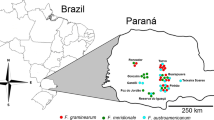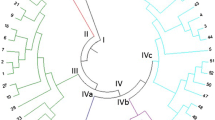Abstract
Fusarium poae has been considered as a minor species among those that cause Fusarium Head Blight (FHB) disease but in recent years several researchers have documented a high frequency of occurrence of this species. In this study, a total of 173 F. poae isolates from Argentina, Belgium, Canada, England, Finland, France, Germany, Hungary, Italy, Luxembourg, Poland, Switzerland and Uruguay were evaluated by using inter simple sequence repeats (ISSR) and amplified fragment length polymorphism (AFLP) to evaluate genetic variability within F. poae and to amplify MAT idiomorphs as a possible mechanism that could explain part of the variability found in this species. The molecular analysis obtained from both molecular markers showed a high intraspecific variability. However, a partial clustering between F. poae isolates and their geographic origin was obtained by ISSR markers while AFLP showed isolates from different geographic locations distributed throughout the dendrogram. Moreover, ISSR grouped all the F. poae isolates into a different cluster from the F. langsethiae and F. sporotrichioides isolates used as outgroups compared with the dendrogram obtained using AFLP markers. Analysis of molecular variance (AMOVA) indicated a high genetic variability in the F. poae collection, with most of the genetic variability resulting from differences within, rather than between, American and European populations by using both molecular markers. Regarding MAT idiomorphs, for most F. poae isolates both MAT-1 and MAT-2 were present from each isolate.



Similar content being viewed by others
References
Agarwal, M., Shrivastava, N., & Padh, H. (2008). Advances in molecular marker techniques and their applications in plant sciences. Plant Cell Reports, 27, 617–631.
Akinsanmi, O. A., Backhouse, D., Simpfendorfer, S., & Chakraborty, S. (2008). Mycelial compatibility reactions of Australian Fusarium graminearum and F. pseudograminearum isolates compared with AFLP groupings. Plant Pathology, 57, 251–261.
Altschul, S. F., Gish, W., Miller, W., Myers, E. W., & Lipman, D. P. (1990). Basic local alignment search tool. Journal of Molecular Evolution, 215, 403–410.
Alvarez, C. L., Somma, S., Proctor, R. H., Stea, G., Mulé, G., Logrieco, A. F., et al. (2011). Genetic diversity in Fusarium graminearum from a major wheat-producing region of Argentina. Toxins, 3, 1294–1309.
Astolfi, P., Reynoso, M. M., Ramirez, M. L., Chulze, S. N., Alves, T. C. A., Tessmann, D. J., et al. (2011). Genetic populations structure and trichothecene genotypes of Fusarium graminearum isolated from wheat in southern Brazil. Plant Pathology, 61, 289–295.
Audenaert, K., Van Broeck, R., Bekaert, B., De Witte, F., Heremans, B., Messens, K., et al. (2009). Fusarium head blight (FHB) in Flanders: population diversity, inter-species associations and DON contamination in commercial Winter wheat varieties. European Journal of Plant Pathology, 125, 445–458.
Bassam, B. J., Caetano-Anollés, G., & Gresshoff, P. M. (1991). Fast and sensitive silver staining of DNA in polyacrilamide gels. Analytical Biochemistry, 196, 80–83.
Cepni, E., Tunali, B., & Gürel, F. (2012). Genetic diversity and mating types of Fusarium culmorum and Fusarium graminearum originating from different agro-ecological regions in Turkey. Journal of Basic Microbiology, 52, 1–9.
Chandra Nayaka, S., Wulff, E. G., Udayashankar, A. C., Nandini, B. P., Niranjana, S. R., Mortensen, C. N., et al. (2011). Prospects of molecular markers in Fusarium species diversity. Applied Microbiology and Biotechnology, 90, 1625–1639.
Conde-Ferráez, L. (2007). El locus mat (mating-type) de los ascomicetos: su evolución, estructura y regulación. Revista Iberoamericana de Micología, 24, 95–99.
Dinolfo, M. I., Stenglein, S. A., Moreno, M. V., Nicholson, P., Jennings, P., & Salerno, G. L. (2010). ISSR markers detect high genetic variation among Fusarium poae isolates from Argentina and England. European Journal of Plant Pathology, 127, 483–491.
Irzykowska, L., Bocianowski, J., & Baturo-Ciesniewska, A. (2013). Association of mating-type with mycelium growth rate and genetic variability of Fusarium culmorum. Central European Journal of Biology, 8, 701–711.
Kerényi, Z., Táborhegyi, É., Pomázi, A., & Hornok, L. (1997). Variability amongst strains of Fusarium poae assessed by vegetative compatibility and RAPD polymorphism. Plant Pathology, 46, 882–889.
Kerényi, Z., Moretti, A., Waalwijk, C., Oláh, B., & Hornok, L. (2004). Mating type sequences in asexually reproducing Fusarium species. Applied and Environmental Microbiology, 70, 4419–4423.
Kristler, H. C., & Miao, V. P. M. (1992). New models of genetic change in filamentous fungi. Annual Review of Phytopathology, 30, 131–152.
Leslie, J. F., & Summerell, B. A. (2006). The Fusarium laboratory manual. Ames: Blackwell Publishing.
Leslie, J. F., Anderson, L. L., Bowden, R. L., & Lee, Y.-W. (2007). Inter- and intra-specific genetic variation in Fusarium. International Journal of Food Microbiology, 119, 25–32.
Lindblad, M., Gidlund, A., Sulyok, M., Borjesson, T., Krska, R., Olsen, M., et al. (2013). Deoxynivalenol and other selected Fusarium toxins in Swedish wheat—ocurrence and correlation to specific Fusarium species. International Journal of Food Microbiology. doi:10.1016/j.ijfoodmicro.2013.07.002.
Manzo-Sánchez, G., James-Kay, A., Ortiz-Vázquez, E., & Simpson-Williamson, J. (2007). Desarrollo de mapas genéticos y físicos de hongos fitopatógenos: aplicaciones y perspectivas. Revista Mexicana de Fitopatología, 25, 54–65.
Mishra, P. K., Fox, R. T., & Culham, A. (2003). Inter-simple sequence repeat and aggressiveness analyses revealed high genetic diversity, recombination and long-range dispersal in Fusarium culmorum. Annals of Applied Biology, 143, 291–301.
Mishra, P. K., Tewari, J. P., Clear, R. M., & Turkington, T. K. (2004). Molecular genetic variation and geographical structuring in Fusarium graminearum. Annals of Applied Biology, 145, 299–307.
Nei, M. (1987). Molecular evolutionary genetics. New York: Columbia University Press. 512 pp.
Nicholson, P., Chandler, E., Draeger, R. C., Gosman, N. E., Simpson, D. R., Thomsett, M., et al. (2003). Molecular tools to study spidemiology and toxicology of fusarium head blight of cereals. European Journal of Plant Pathology, 109, 691–703.
Ouellet, T., & Seifert, K. A. (1993). Genetic characterization of Fusarium graminearum strains using RAPD and PCR amplification. Phytopathology, 83, 1003–1007.
Parry, D. W., & Nicholson, P. (1996). Development of a PCR assay to detect Fusarium poae in wheat. Plant Pathology, 45, 383–391.
Qu, B., Li, H. P., Zhang, J. B., Xu, Y. B., Huang, T., Wu, A. B., et al. (2008). Geographic distribution and genetic diversity of Fusarium graminearum and F. asiaticum on wheat spikes throughout China. Plant Pathology, 57, 15–24.
Rohlf, F. I. (1998). NTSYSpc. Numerical taxonomy and multivariate analysis system version 2.0. Applied biostatistics. New York: Exeter Software.
Schneider, S., Roessli, D., & Excoffier, L. (2000). Arlequin. Version 2.0: A software for populations genetic data analysis. Switzerland: University of Geneva.
Sneath, P. H., & Sokal, R. R. (1973). Numeral taxonomy. San Francisco: Freeman.
Somma, S., Alvarez, C., Ricci, V., Ferracane, L., Ritieni, A., Logrieco, A., et al. (2010). Trichothecene and beauvericin mycotoxin production and genetic variability in Fusarium poae isolated from wheat kernels from northern Italy. Food Additives and Contaminants, 27, 729–737.
Stenglein, S. A., & Balatti, P. A. (2006). Genetic diversity of Phaeoisariopsis griseola in Argentina as revealed by pathogenic and molecular markers. Physiological and Molecular Plant Pathology, 68, 158–167.
Stenglein, S. A., Dinolfo, M. I., Bongiorno, F., & Moreno, M. V. (2012). Response of wheat (Triticum spp.) and barley (Hordeum vulgare) to Fusarium poae. Agrociencia, 46, 299–306.
Su, H., Wang, L., Liu, L., Chi, X., & Zhang, Y. (2008). Use of inter-simple sequence repeat markers to develop strain-specific SCAR markers for Flammulina velutipes. Journal of Applied Genetics, 49, 233–235.
Vogelgsang, S., Enkerli, J., Jenny, E., Roffler, S., & Widmer, F. (2010). Characterization of Fusarium poae microsatellite markers on strains from Switzerland and other countries. Journal of Phytopathology, 159, 197–200.
Vos, P., Hogers, R., Bleeker, M., Reijans, M., van de Lee, T., Hornes, M., et al. (1995). AFLP: a new technique for DNA fingerprinting. Nucleic Acids Research, 23, 4407–4414.
Yun, S.-H., Arie, T., Kaneko, I., Yoder, O. C., & Turgeon, B. G. (2000). Molecular organization of mating type loci in heterothallic, homothallic, and asexual Gibberella/Fusarium species. Fungal Genetics and Biology, 31, 7–20.
Acknowledgments
The authors thank Dr. Paul Nicholson for critical comments and suggestions on improving this manuscript. This research was supported by FONCYT PICT 110/2008 and 030/2011, CONICET and UNCPBA.
Author information
Authors and Affiliations
Corresponding author
Rights and permissions
About this article
Cite this article
Dinolfo, M.I., Castañares, E. & Stenglein, S.A. Characterization of a Fusarium poae world-wide collection by using molecular markers. Eur J Plant Pathol 140, 119–132 (2014). https://doi.org/10.1007/s10658-014-0448-z
Accepted:
Published:
Issue Date:
DOI: https://doi.org/10.1007/s10658-014-0448-z




